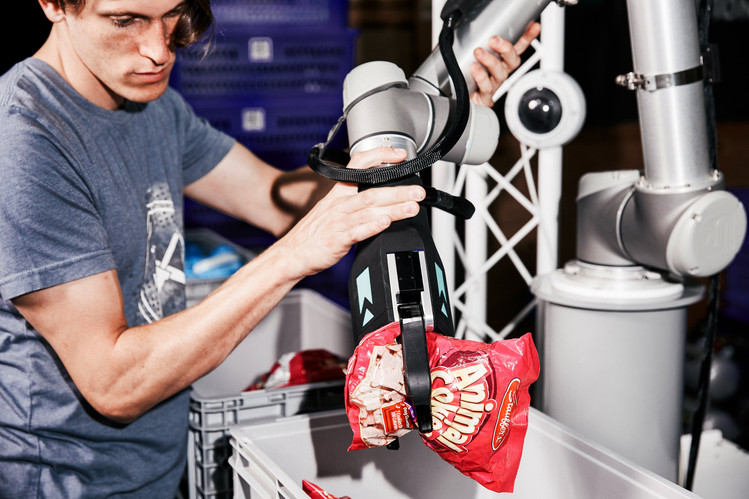In this Week’s Issue:
- A Quick Economic Recap
- Data on Tap for the Week Ahead
- A New Contender for Tooling & Retooling Thanks to Aerospace Mandates!
- Amazon (AMZN) and Alphabet (GOOGL) both flirt with the $1,000 price line
- Dycom (DY) shares hit hard, but thematic tailwinds are still strong
We here at Tematica hope you had an enjoyable and relaxing holiday weekend that also served as a reminder for all those who fought so we can enjoy the freedoms we have. Three-day weekends serve to help recharge one’s batteries and we’ll need it this week. We have a plethora of economic data coming at us, which will set the stage for the European Central Bank’s next meeting (June 8) as well as the next Federal Open Market Committee meeting (June 13-14). With the Fed’s most recent FOMC minutes indicating the group is looking to determine if the recent economic slump was indeed transitory, we expect there will be much focus on this week’s data.
 Odds are that will be a hot topic of this week’s Cocktail Investing Podcast, and if you missed last week’s episode then you missed out on our restaurant pain conversation. Of course, if you head over to TematicaResearch.com you can find that episode there, or you can simply subscribe to the podcast on iTunes – you can guess which one I’d recommend, so you don’t miss out.
Odds are that will be a hot topic of this week’s Cocktail Investing Podcast, and if you missed last week’s episode then you missed out on our restaurant pain conversation. Of course, if you head over to TematicaResearch.com you can find that episode there, or you can simply subscribe to the podcast on iTunes – you can guess which one I’d recommend, so you don’t miss out.
A Quick Economic Recap
Because there was no Monday Morning Kickoff published this week, let’s recap last week and what it meant for the Tematica Select List. As the market ground higher last week — setting new records for both the S&P 500 and the Nasdaq Composite Index — there were added signs that even though the domestic economy is faring better now than in the first quarter, it’s still not setting the world on fire.
We saw evidence of a struggling economy in Friday’s April core durable goods order data and in disappointing April new home sales earlier last week. While this morning’s April Personal Income & Spending were in-line with expectations, we have to remember April spending benefitted from the late Easter holiday. Digging into the report, the biggest spending increase was for durable goods, while spending on services fell month over month. The personal savings rate remained flat at 5.3 percent for the third consecutive month. Unsurprisingly, the latest Case-Schiller 20-city index, which seeks to measures the value of residential real estate in 20 major U.S. metropolitan areas, rose once again in March reflecting the continued shortage of available homes for sale that is benefitting sellers and helping drive prices higher.
Even the latest Fed minutes that came out last week showed some debate as to the nature of the recent economic slowdown. Then on Friday, St. Louis Fed President James Bullard shared his view that the path of inflation in the U.S., which has started to roll over according to the latest data, is “worrisome.” Bullard, who is not a voting member of the Federal Open Market Committee (FOMC), went on to reiterate his dovish view that the central bank is seeking to hike rates too quickly and by too much. As we have said before, the Fed has historically done a great job of hiking rates right into a recession… hopefully, Fed Chairwoman Janet Yellen realizes this.
From our perspective, we continue to see the prospects for growth challenged by rising debt levels, little to no wage growth and the headwind of an aging population that, over time, will sap the available workforce pool. Per Economics 101, it’s pretty hard to grow an economy if there aren’t people there to work or as another put it this morning, “the reality of an economy slowed by an aging population and a lack of worker productivity growth.”
Despite some early wins on President Trump’s overseas tour, his approval rating remains below 40 percent, according to the latest from Gallup. As if this wasn’t enough, the Congressional Budget Office reported the GOP Health Plan would result in 23 million fewer Americans with health insurance — fodder for the 2017 election season and likely to help embolden Democrats to resist working with the president to instill reforms until at least mid- November. What’s more, it should weigh on GDP and earnings expectations in the back half of 2017.
As we enter the 2017 campaign season, we’ll continue to read the tea leaves in Washington to assess the potential timing of Trump’s policy moves (late 2017-early 2018?) as well as the potential impact on the markets.
Data on Tap for the Week Ahead
Turning back to the week ahead, as we mentioned above it’s a rather intense one of the economic front, and with the Fed’s comments, it likely means the data will be in focus even more than usual. Luckily, we have no portfolio companies reporting earnings, which will allow us to zero in on the data, and possibly put some more of our cash to work
On deck over the next few days, we have May ISM Manufacturing & Services, the ADP and the Bureau of Labor Statistics May Employment reports, as well as the official PMI data for May from Markit Economics all, arrive over the next few days. Also, don’t forget May auto sales, April construction spending and the Fed’s latest Beige Book. Be sure to check back later in the week at TematicaInvesting.com for our take on the data.
Yep, it’s going to be a humdinger of a week for economic numbers, and making it even more interesting, a few Fed speakers are on tap. As we contend with the what’s ahead, we’ll continue to look for well-positioned companies that shine through our thematic investment perspective and offer a favorable net risk to reward trade-off. In the meantime, should we uncover some well-positioned companies that have some potential, but we need to see the fundamentals firm or the share price come in a bit, we’ll put them on the Contenders List. Speaking of which . . .
A New Contender for Tooling & Retooling Thanks to Aerospace Mandates!
There are several strategies investors use to uncover companies that are poised to be on the receiving end of improving demand. We can track industry data looking for a rebound or acceleration that point to rising demand, like many do with companies like CSX (CSX) and Norfolk Southern (NSC) for example.
We can look for new and disruptive technologies that are changing the playing field within an industry, and one such example is our Universal Display (OLED), which as subscribers know is poised to benefit from the shift in smartphones, TVs and wearables to organic light emitting diode (OLED) displays from light emitting diode (LED) backed liquid crystal displays (LCDs). Another strategy is to look for pain points and identify those that can solve the chokehold.
There are others of course, including technical tools, but we can also look to regulatory mandates to help uncover potential pain points and the companies that could benefit. While there tends to be some back and forth in DC over regulatory mandates, once they are agreed upon and the timeline is set, we have a line in the sand that results in companies complying or potentially being fined. That line in the sand tends to result in a pull-forward in demand and historically speaking a falloff in demand once the timeline has been achieved.
We’ve seen this demand pull-forward in the trucking industry with new engine emission mandates and in the rail industry with braking technology mandates. We’re in the process of seeing this with another mandate in the trucking industry as fleet operators have until December 2017 to meet the electronic logging device (ELD) mandate to track hours of service. Compliance with this mandate is one factor leading to rising demand for our CalAmp (CAMP)shares, which have climbed more than 29 percent year to date.
Another industry that has its fair share of staged regulatory mandates is aviation. We’ve seen several mandates over the last decade plus, including one to compress the distance between flying aircraft. This was better known as Reduced Vertical Separation Minimum or RVSM for short. Much like mandates for trucks, railcars and others, the addressable market included both new aircraft as well as the existing fleet, which works very well for those companies that serve the after-market. With recent and even newer technologies, we are seeing another round of global mandates that phase in this year, but there is a larger looming mandate for air traffic management in both the US and Europe called Automatic Dependent Surveillance-Broadcast (ADS-B).
Automatic Dependent Surveillance–Broadcast (ADS-B) helps pilots and air traffic controllers create a safer, more efficient National Airspace System (NAS) relies on aircraft avionics, a constellation of GPS satellites, and a network of ground stations across the country to transmit an aircraft’s position, ground speed, and other data to air traffic controllers. Compared to existing radar, the coverage area and accuracy is greater and it can be used in areas where radar coverage is not possible, such as over the Gulf of Mexico. ADS-B also transmits surveillance information about an aircraft in flight or while on the ground. In the US, the Federal Aviation Administration has mandated that aircraft operating in most controlled U.S. airspace be equipped for ADS-B Out by January 1, 2020 and in Europe retrofit compliance is set for June 8, 2020.
Per data from Boeing there were 22,520 jet airplanes in service during 2015, and the over the next 20 years that figure is slated to rise to more than 45,000. This bodes well for those companies like Honeywell (HON) and Rockwell Collins (COL) that serve the OEM aircraft market, but those more than 22,000 planes offer a meaningful retrofit opportunity.
One of the companies that benefitted from the RVSM mandate several years ago was Innovative Solutions & Support (ISSC), which saw its shares climb to more than $24 in 2005 during the height of RVSM compliance. In a nutshell, the company is an avionics company that saw its revenue swell to more than $63 million in 2005, up from just over$28 million in 2003 before rolling over to roughly $18 million in 2007. Over the years, the company continued to innovate with new avionics products, including flat panel displays, and despite the revenue fall off from the RVSM heydays, the company has continued to generate respectable gross margins while still funding new product development.
Currently, there is one lone analyst covering the stock and no published earnings estimates, which can make valuing the shares a little challenging. It can also mean the shares are a potential diamond in the rough.
- As we look to get a better understanding of the ADS-B and other pending aerospace/avionics mandates, we’re adding Innovative Solutions & Support (ISSC) shares on the Tematica Contender’s List, which is where we list companies that we’re doing more work on and in some cases we’re waiting for the risk to reward trade-off to reach a more appetizing level.
- We’ll keep you posted on our analysis as we zero in on our valuation of ISSC shares and decide when to move them from a contender to a player.
Amazon (AMZN) and Alphabet (GOOGL) both flirt with the $1,000 price line
From our perspective, we see Amazon crossing that mark on a sustained basis first as it continues to expand its purview on both a service/product offering and a geographic one. Make no mistake, we see Alphabet shares crossing that line too, it’s just likely to take a bit longer as it contends with growing competition in the digital advertising space from the likes of Facebook (FB) and now Amazon (AMZN). That said, as we see advertisers continue to embrace our Connected Society investing theme it means more ad dollars flowing to streaming and digital platforms, which bodes well all three of these companies.
- Our price target on AMZN shares remains $1,100, which offers just 10 percent upside and this has us reviewing both our price target and potentially our Buy rating on the shares.
- Following the strong share price runs for both GOOGL and FB, we continue to rate both Hold. Please note, that is not code for Sell, but rather a true Hold as all three of these are stocks to own, not trade.
Dycom (DY) shares hit hard, but thematic tailwinds are still strong
Last week, following the company’s quarterly earnings report that offered a softer than expected near-term outlook, Connected Society player Dycom Corp (DY) shares came under significant pressure, dropping over 25 percent. Of course, we’re still up slightly from when we initiated our positions back in September and October of last year, all of which spells opportunity.
The issue with DY shares essentially boils down to a combination of timing and investor expectations. During the quarter, the mild winter weather allowed Dycom to pull forward projects from the current quarter, and odds are investor enthusiasm for 5G deployments has gotten a tad ahead of itself helping DY’s share price soar to a 52-week high of $110 this month from the low $80s in January.
DY shares are now back at early January levels, but from a fundamental perspective, we continue to see both cable and mobile operators expanding existing network capacity and launching new, next-generation networks to meet the nearly unquenchable demand for data. The silver lining in all of this is Dycom is seeing a broadening set of customer opportunities that are in the initial stages of planning, engineering and design and deployment. Also noted on the company’s earnings call, the company is continuing to win contracts, as customers work to improve their network capabilities and performance.
This brings us back to timing, and that means keeping tabs on Dycom’s customer base and respective network-capacity additions and new technology deployments, such as fiber to the home and business as well as 5G backhaul. We’ve seen timing bumps like this in the past with Dycom and other companies like it, and these pullbacks tend to present a buying opportunity — provided the fundamentals remain intact. Based on what we are hearing and seeing from the consumers and Dycom’s customers, we believe that to be the case.
- We continue to rate DY shares a Buy with a $115 price target.
- Subscribers that missed DY shares earlier this year should use the recent drop to either add to or begin a position in DY shares.







